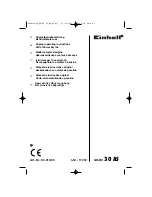
-23-
Always set the cutting depth
approx. 2 to 5 mm (1/16 to 3/16 in.)
larger than the material thickness
to be cut.
5.4 Setting for bevel cuts
For bevel cuts, the saw unit can be set to any angle
between 0 and 45°.
Unfasten the wing nut 10 (Fig. 2)
Adjust the angle according to the scale on the
segment for tilting.
Afterwards, tighten the wing bolt 10.
5.5 Setting for mitre cuts
Release the limit stop 21 (Fig. 1) and adjust the
angle according to the scale on the guide rail.
Retighten the limit stop.
Apply the machine to the workpiece to be
processed with the two stop bolts on the bottom
side of the guide rail and execute the cut by
pushing the machine forward.
After the cut, return the saw to its starting
position by retracting it.
5.6 Plunge cuts
Danger
Risk of backlash during plunge
cuts! Prior to plunging, place the
machine with the rear edge of its
base plate against a limit stop
fastened on the workpiece. Keep a
firm hold on the machine handle
during plunging and push the saw
lightly forward!
Unfasten the clamping lever 11 (Fig. 2).
Set lever 6 to position "-2" on scale 7 .
Use the integrated handle 14 (Fig. 3) to
completely open the retractable saw guard so
that the machine can be placed onto the
workpiece to be processed. The saw blade is
now running freely above the material and can
be aligned for tracing.
Switch on the machine only now.
Press the plunge lever 6 (Fig. 2) downwards.
This causes the saw blade to plunge vertically
into the workpiece. The plunging depth can be
read from scale 7. The riving knife / splitter
swings up and away when the blade enters the
workpiece. As soon as the slit behind the saw
blade is cleared during the forward motion of the
machine, the riving knife reverts to its normal
position.
5.7 Sawing according to tracings
with guide rail
When sawing according to tracing, the right edge of
the guide rail serves as tracing indicator. This also
applies to bevel cuts. Please take note of chapter 5.4.
For sawing, place the guide rail onto the
workpiece.
Switch on the machine (see Chapter 5.2) and
slide the machine evenly in cutting direction.
When the cut is completed, switch off the saw
by releasing the switch trigger 2 (Fig. 1)
While it is resting on the workpiece, pull the
machine back into home position and in this
position remove it from the workpiece.
Proceeding in this manner ensures that the
retractable saw guard is completely closed.
without guide rail
Danger
When sawing without guide rail it is
imperative to mount the enclosed
support bracket or parallel stop. It
serves as double support for an
improved guidance of the machine
and for your safety.
You can detach the machine from the guide rail
towards the rear by pressing the ratchet 20 (Fig. 1).
The base plate has two tracing edges 17 (Fig. 3) for
0° and 45°. These tracing edges correspond to the
saw blade's inside. For bevel cuts, the tracing can be
viewed through the opening on the left-hand side of
the upper saw guard.
















































